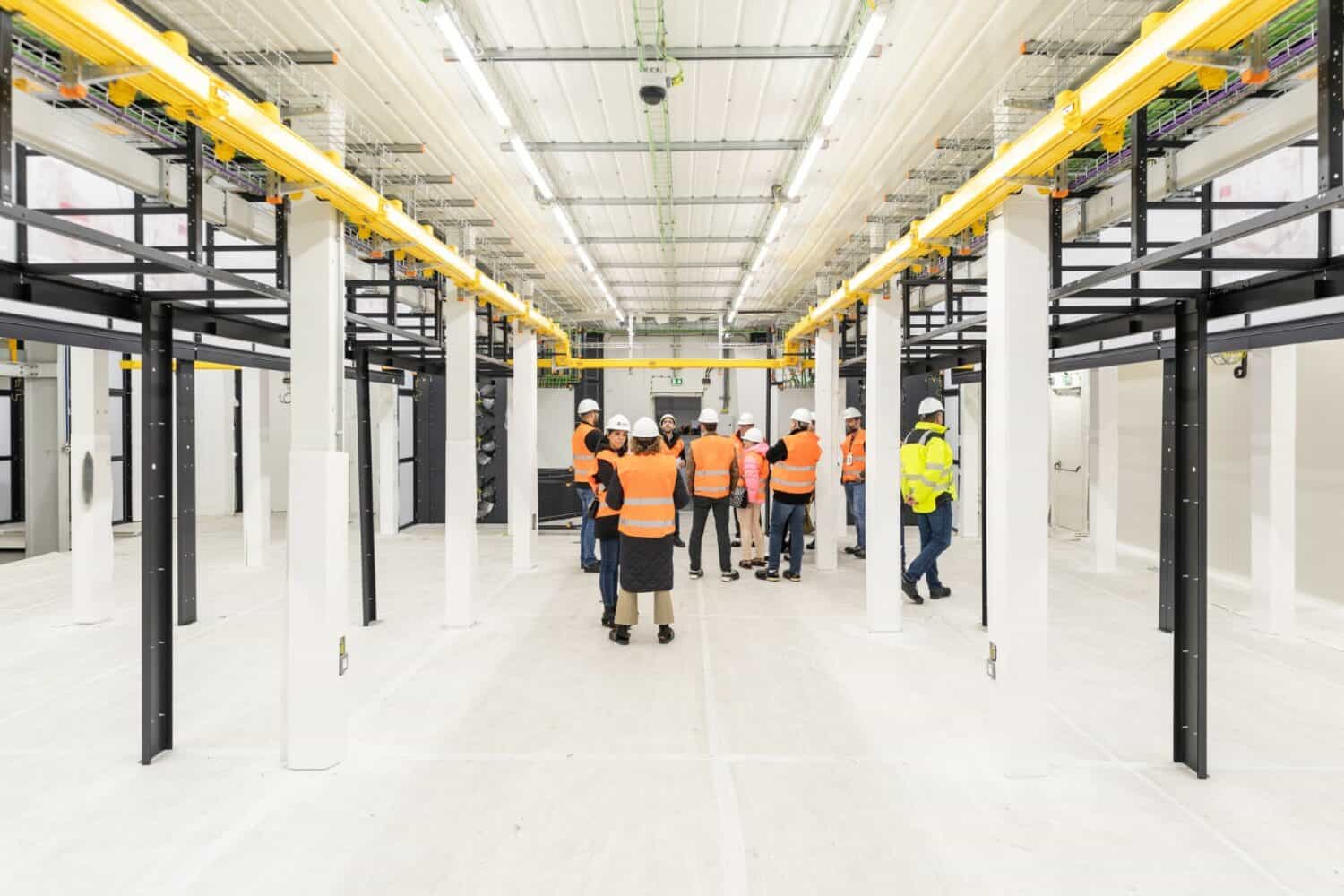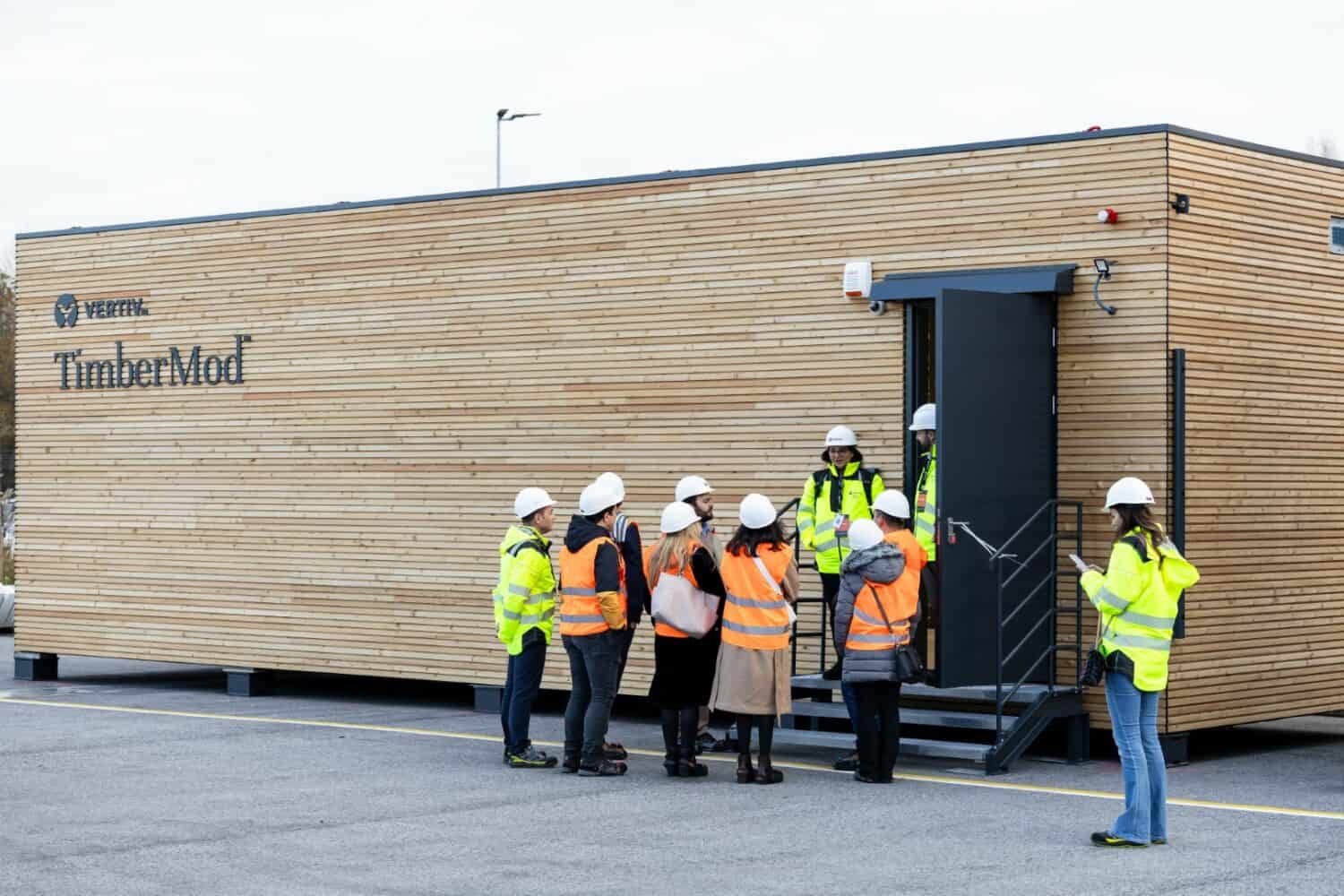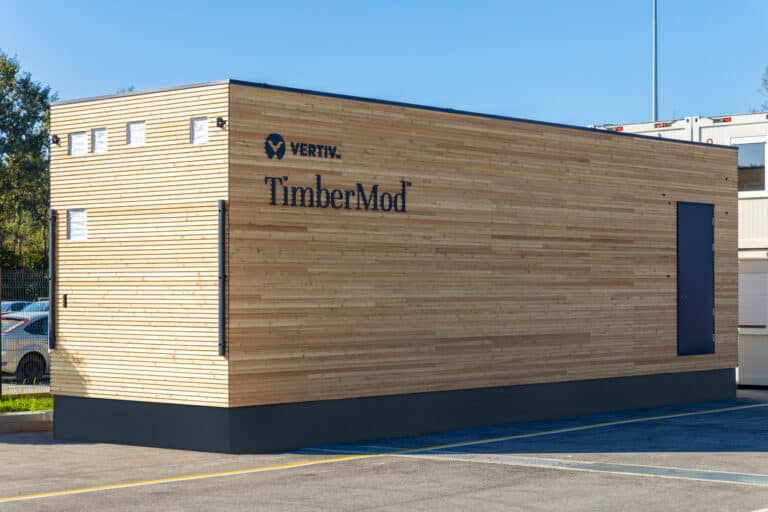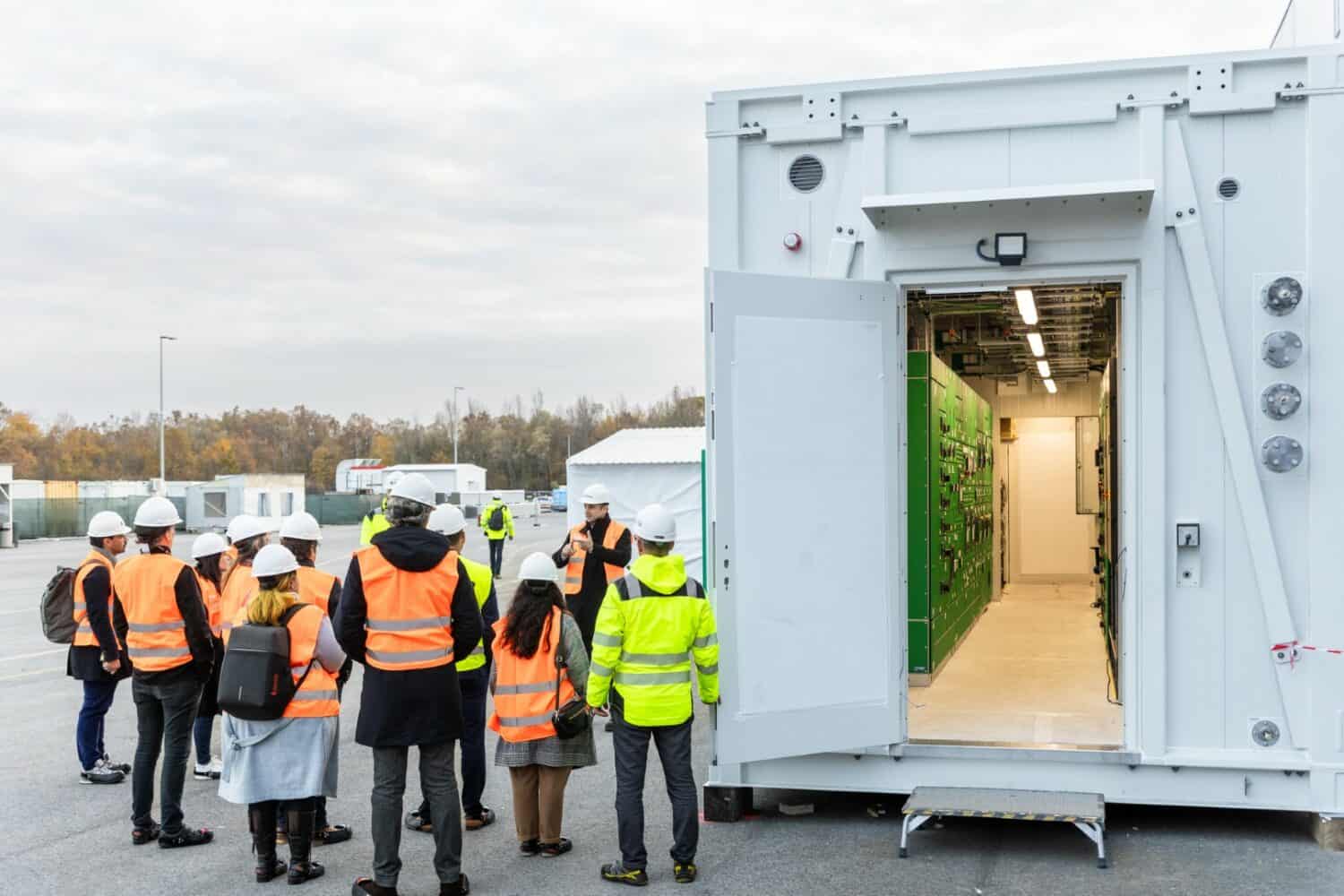Vertiv today announces an expansion of its prefab modular offerings. TimberMod is made of wood. It should boost the general rise of prefab modular data center construction.
Last week we were guests in Rugvica, Croatia at Vertiv. A few years ago, the company commissioned a factory there dedicated to building PFM solutions. PFM stands for Prefabricated Modular. That means Vertiv builds prefabricated modules for data centers there. These can be complete data centers or just the module to provide power, for example.
Today Vertiv announces the latest member of this family. TimberMod is not so much a new product as a new way to build the modular products. Namely, these modules are built of wood, not metal. We got a peek at one such new TimberMod last week and had the opportunity to ask some questions about it.
PFM is not new
Before we get into what Vertiv has to offer in terms of PFM, let’s first briefly outline the history of this type of data center construction. After all, it is not new. In the first decade of this century, there were data centers in shipping containers. Sun Microsystems really kicked off this trend in 2006, with Sun Modular Datacenter (also known internally as Project Blackbox). Soon other players followed suit, such as Dell, HP and IBM.
The prefab modules marketed by companies such as Vertiv, which we now refer to as PFM, are not the same as those of the manufacturers mentioned above. They no longer use standard sized shipping containers. We learn during our visit to Vertiv’s factory in Croatia that they can make the modules in all kinds of sizes. For example, the length of a module can be up to about 16 meters. However, the height and width are always more or less the same as far as we have seen. This is due to the fact that the prefabricated parts can also be joined together. In other words, it is a modular system. Then you don’t want too many fluctuations in height and width.
The limitations in the length of the PFMs are there for a very simple reason. It has to do with the size of the trailers and trucks that will eventually have to transport them. That is, they have to fit on a truck trailer. In addition, of course, it must also be possible to put them where they have to go on the actual data center site. If you make transporting and handling these types of components too difficult, then a PFM loses some of its appeal. So the key is to balance size and manageability.
Vertiv is a market leader in PFM
Vertiv is a major player in our region in the market of prefabricated modular components for data center construction. We hear during the event in Croatia that Vertiv is clearly the number one player in Europe. Looking purely at Western Europe, the lead over the number two is even greater. This states Omdia analyst Vlad Galabov, who is responsible for Cloud and Data Center Research at this analyst firm.
Vertiv went fully for the PFM market in 2010, but already built it’s first modules in 2001. By now it has a fairly extensive offering. According to Viktor Petik, VP Integrated Modular Solutions EMEA at Vertiv, the company has introduced more than 1,500 modules to the market since it started.
SmartMod, MegaMod, Power Module
Looking at what Vertiv has to offer, the first products are the Vertiv SmartMod and SmartMod Max. These are all-in-one data centers, which consist of individual modules. Vertiv builds everything in one module and delivers it to a customer completely finished. This is not truly modular, by the way. You purchase this as a complete data center, as mentioned above. It is not the intention that you connect this with a second module to make a large data center. Hence, there are two sizes.
In addition to the standard solutions, however, Vertiv also has the “real” Prefabricated Modular solutions. These make it possible to scale up to data centers of up to 2 megawatts of available power. You can achieve this by connecting as many modules together as needed. This involves 200-300 racks. Again, Vertiv has come up with a kind of standardized variant, the Vertiv MegaMod. You can build this from a module of 128 racks or 0.5 megawatts or a module of 256 racks or 1 megawatt, in combination with a so-called Power Module. Vertiv builds the entire setup in the factory. They test that everything works properly and then disassemble it again, to transport each module separately and assemble it on site.

A Power Module is again a fully assembled module, which you connect to one of the other modules. With this, you immediately add the complete power supply for an entire data center, or part of it. The convenient thing about a Power Module is that you place them completely outside a data center. That makes them easily accessible and they are never in the way, either. Even if there are problems with the power supply and a fire threatens, for example, there is natural separation.
Power Module is the most popular product in Vertiv’s PFM line. It accounts for a relatively large portion of the more than 1,500 modules sold. This is not surprising, of course, since you usually need more than one of these at a data center. They can additionally be delivered together with SmartMod and non-standardized solutions such as MegaMod.
Just for completeness, SmartMod and MegaMod themselves consist of different modules. In addition to a Power Module, they also include a Cooling Module and an IT Module. These individual modules are often made specifically for a customer. We saw a Cooling Module that Vertiv designed together with this customer during a tour of a MegaMod data center intended for the French market, which consists of no less than sixteen individual modules (see picture elsewhere on this page).
AI should accelerate growth
Currently, PFM represents a market value of some four billion dollars, we hear from Omdia’s analyst. Given the annual capex data center spending of hyperscalers of $25 billion, that doesn’t strike us as a huge market yet. However, Galabov also sees that there is going to be a lot of investment in AI infrastructure this year and next. That will also have an impact on the PFM market, he expects. He thinks that four billion may well double in about four years.
What will come out of Omdia’s predictions is anyone’s guess. That the need for AI infrastructure is going to boost the entire data center market, however, is a no-brainer. The PFM market will then naturally go along with it. Indeed, if AI is a reason for companies to set up their own (small) data center again, for example because they like to train an LLM locally on their own data, then a PFM data center is quite attractive.
Why is a PFM data center actually interesting?
In the body of this article, we assume that PFM data centers are interesting for organizations. But why is that actually the case? This question in itself is fairly easy to answer. At least five advantages can be thought of on paper:
- Speed of design and deployment;
- Simplicity and scalability of design;
- High-quality, uniform finishing of the modules;
- Cost certainty;
- Cost-effective design.
Of the above five potential reasons to go for a PFM data center, the top two are undoubtedly the most important ones for customers. Research by Omdia also shows that. Especially now that organizations must respond relatively quickly to what AI, among other things, will mean for them.
Vertiv TimberMod: sustainability in the mix
An article about data centers is not complete without mentioning the topic of sustainability. So that is what we are working toward in this article. Prefab modular construction in itself is of course very interesting and it is good for Vertiv that there is still a nice bit of room to grow in the data center market in general and the PFM data center market in particular. However, it would also be nice if this could all be achieved somewhat sustainably. From this perspective, Vertiv today introduces an interesting new product in its PFM offering, namely TimberMod.
The name TimberMod already gives a little indication of what we are talking about here. We are talking about a module made of wood. TimberMod replaces the standard metal housing of Power Module and SmartMod, if customers want it. During the tour, Vertiv spokesmen indicated that MegaMod designs can also be built with TimberMod in principle. However, that is not what Vertiv is officially announcing today.

A data center made of wood, is that even possible?
At first glance, it may seem like an odd combination, a data center built from wood. However, that seems to be more perception than reality. Timber frame construction has been around for a long time. Not only for smaller projects, but also for multi-story buildings. So it can be made strong enough for data center uses too. Even stacking multiple PFMs on top of each other is a possibility.
Data centers are already being built out of wood, by the way. We hear this, among other things, during a panel discussion as part of the event. There, Mikael Svanfeldt, CTO of Sweden’s EcoDataCenter talks about how they are building that data center entirely out of wood. Photos shown during the session support his story.
One of the first questions asked when it comes to wooden data centers is what about fire safety. After all, wood is natural fuel for fire. However, the wood Vertiv uses for TimberMod is not fresh, raw wood. It has been treated in such a way that it is not inferior to metal when it comes to fire safety. We don’t quite get to the nitty gritty of what this treatment looks like exactly. We are assured, however, that no chemicals are used. It is mainly a special way of letting the wood dry out, we understand. Tests show that a wooden data center is no more a fire hazard than a metal one.
More sustainable step by step
The addition of TimberMod to Vertiv’s offering is good news for the discussion around data center sustainability. We’re only going to need more of them, so it’s good to know it’s possible to do this in a more responsible way. Mind you, if everyone is going to do it en masse, of course there is again the risk of not having enough wood. It is therefore important to mention that it is an addition to the range, not a complete replacement of existing ways of building data centers.
Svanfeldt incidentally drops an interesting fact on this point during the panel discussion. According to him, the trees in Sweden regrow the wood used to build the EcoDataCenter in 14 minutes. That sounds like some creative math there, but it’s also too interesting a factoid not to mention as far as we’re concerned. In any case, it indicates that using wood to build data centers has legs. And that’s a good sign if we want to move towards a more sustainable future that includes more data centers.
Also read: “There’s no shortage of energy, there’s too much energy waste”

